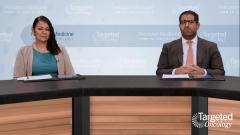
CEACAM5 Testing in Clinical Practice
Experts share their approach to CEACAM5 testing, including the testing procedure, patient selection criteria, and timing of testing.
Episodes in this series

Joshua Sabari: Dr. Florez, you mentioned in IHC, is this something that you have to get a slide and send to your pathologist? Can I test this in the peripheral circulation with liquid biopsy? A lot of my colleagues are using liquid biopsy. Is something you need tissue for in order to understand the sort of level of expression of CEACAM5?
Narjust Florez: I cannot miss the opportunity to say tissue is the issue after that question. In this case, we do need a tissue for testing. With circularity tumor DNA, we're doing extraction of DNA, which [00:15:00] has advanced the field significantly per CEACAM5. We still needed tissue for the staining to determine if the patients are highest presence or not.
Joshua Sabari: So clearly you need tissue. You need a minimum of two to three slides. These need to be unstained. One of the common questions that comes up when we start talking about some of these antibody drug conjugates is, how are you going to test for all these different biomarkers? Now we do PD-L1 and we get that back within 24, 48 hours. Remember, we sit on our hands. We don't give an immunotherapy until we have all of the molecular testing back. But how are you going to get MET, and HER2, HER3, and TROP2? Does it matter? Clearly, I think for some of the data we're going to talk about CEACAM5 expression is important. You want to deliver the therapeutic to patients who are going to benefit. In your own practice, how are you liaising with your pathologist to get these stains these markers done?
Narjust Florez: Well, I think my pathologist is close to getting a restraining order against me. But what we're trying - what I do is - I believe we need to create a lung cancer package. In which we not only test for molecular and PD-L1, but we test for upcoming biomarkers. Why? Even if you don't have a target therapy approved, there are clinical trials that patients can go on. It will be at lung cancer comprehensive panel that includes next-gen sequencing, DNA and RNA. Includes IHC for CEACAM5, includes ISC for HER2 as well. Because that will be developed not only the HER mutation, but the HER2 expressions will continue to develop. We continue to learn. Of course PD-L1. One thing that is very important to discuss when we do testing is that the cancer will evolve over time. So we often need to test at the time of disease progression, because things will change. And that's what these new biomarkers are very common as a resistant mechanism to at initial mutation. So you may see a higher expression, a new molecular profile, after the patient had been in targeted therapy for a while. We cannot see lung cancer as a static shot picture at the moment of diagnosis. It needs to be seen as a continued disease that will continue to evolve. And another to attack it appropriately, we need to know what we're dealing with that day. Not two years ago when the patient was initially diagnosed.
Joshua Sabari: So tissue is the issue. I couldn't agree more. Also some of these dynamic biomarker is actually for CEACAM5. I'm not sure how dynamic. But if you look at CEA, I don't check it commonly in my clinical practice from peripheral circulation or even on IHC. But you don't know that that changes over time. Clearly in patients receiving targeted therapies, MET and HER2 expressions can change broadly. As you mentioned, there's a lot of heterogeneity in these tumors as well.







































